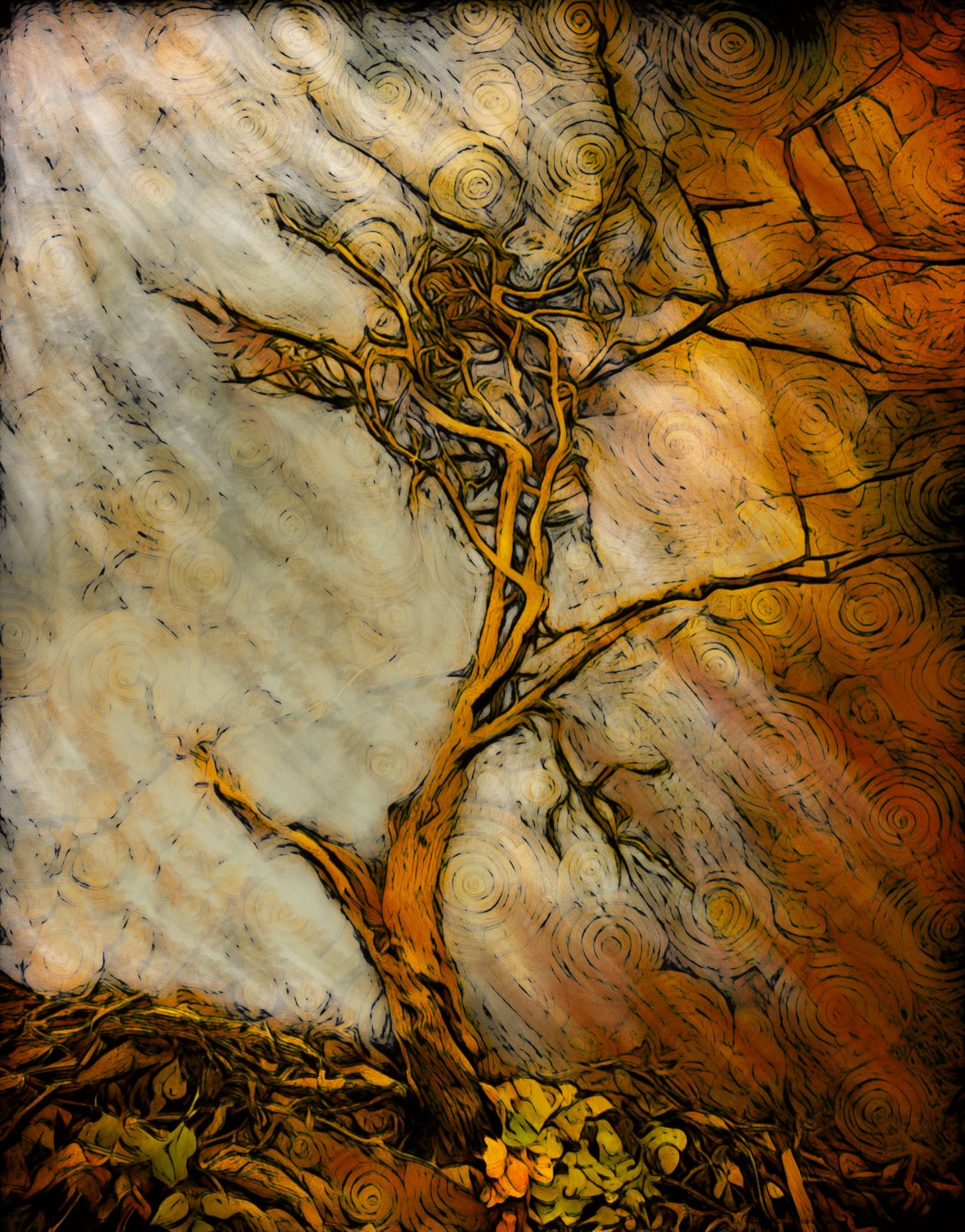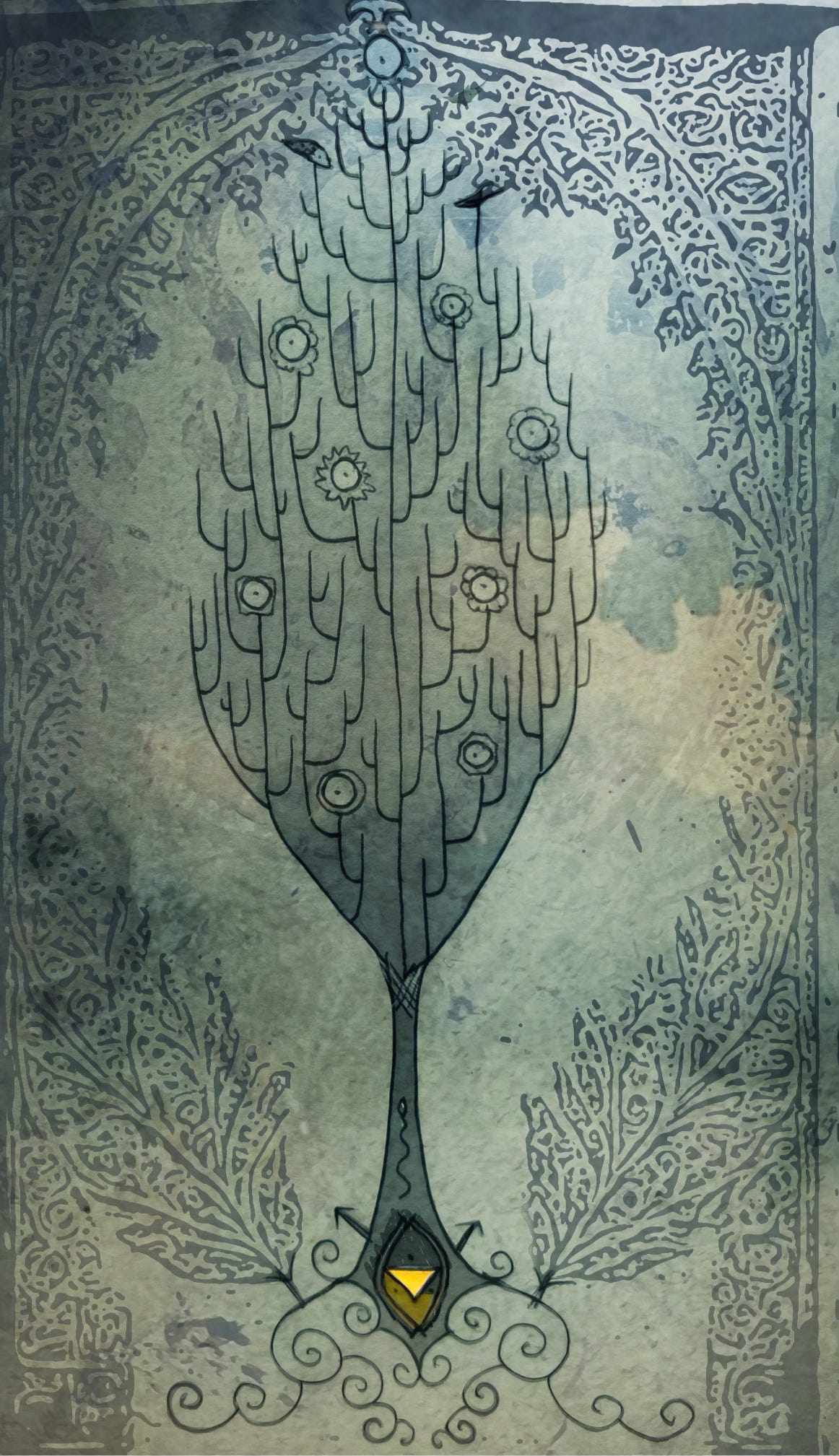The Universal Tree
The Tree of Life in Ancient Cultures
In essence the World Tree represents the universe. In Norse myth Yggdrasil, the sacred ash joins the underworld and the higher realms of the gods. Within its branches are suspended nine worlds, while various attendant animals and monsters gnaw at its leaves, roots and fruits. Still, it replenishes itself for it is a symbol of the life-force itself.
The Norse weren’t alone in choosing the tree to symbolise such a powerful idea. The Mayan World Tree rose through the three spheres of existence. Egyptian, Mesopotamian and Altaic beliefs featured a seven-branched Tree Of Life. In the Egyptian version the Goddess of Destiny sat in the lower branches** and the tree was called aam or aama. For the Abakhan Tatars a seven-branched birch tree grew atop an iron mountain. In Chinese mythology the Cosmic tree grew at the centre of the universe, where the perfect capital was to be found; this sacred tree united the Nine Springs with the Nine Worlds. The Irish Dindsenchus mentions huge trees marking the assembly place for the gods, who were linked with the fate and choice of legendary kings. The World Tree of the Yakut of Siberia was called Yryn-al-tojon.
Hindu philosophy makes reference to a Pipal tree, also known as Ashvattha (mentioned in Buddhist texts as the Bodhi tree, under which the Buddha meditates). In The Mahabharata it is stated: ‘He who worships Ashvattha daily worships the whole universe.” Indeed Krishna said: “Among all trees I am Ashvattha.” And in the Padma Purana: “Ah, there is nothing on earth as great as Vishnu in the form of an Ashvattha tree.” Even today Pipal trees are venerated by Hindus in some areas of India. The trees are circled clockwise, wrapped in coloured cord and offered gifts of water, food, flowers, incense and lamps. As with many belief systems the whole is personified in the fragment.
Its roots above, its branches below,
This is the eternal banyan* tree.
That alone is the bright!
That is Brahman!
That alone is called the immortal!
On it all the worlds rest;
Beyond it no one can ever pass!
(Upanishads - trans. Patrick Olivelle)
The Lapps used to sacrifice an ox to an inverted tree (as a god of vegetation) - while in Hebraic tradition the Tree Of Life was inverted, as was the Islamic Tree Of Happiness. An excavation of a site off the coast of Norfolk, dated to around 2000-2500BC, featured fifty-five split oak trunks arranged in a circle around a central inverted oak stump (buried in the ground). It became known as Seahenge and it was 'excavated' and preserved in 1999.
The above examples attest to the longevity of this symbolism. In fact a great many Shamanistic faiths make reference to the World Tree rising through different realms (usually three, seven or nine) and it’s associated with the axis-mundi or sacred centre. For example, in the hymns of the Vasyugan Ostiak shamans, the Cosmic Tree has seven levels; it passes through all the heavenly spheres and buries its roots in the depths of the earth.
Thus the Sacred Tree was long seen as a symbol of the cosmos, maintaining the forces of life and endless fertility. Not only does the tree tower from the centre of the world, it supports the heavens and can be represented as a pillar. The Altai peoples believe that the gods attached horses to it, while in Scandinavia Odin tethered his horse to Yggdrasil. The Saxons called this cosmic pillar Irminsul-universalis columna quasi sustinens omnia – The Universal Irminsul that sustains everything. The Maypole is a lingering refrain from this mythos.
It’s not difficult to imagine how the ‘resurrection of Christ’ might have been tweaked to fit early narratives. As Christian evangelists sought to convert the pagans they sprang at the chance to incorporate World Tree imagery into their monuments. In Christian mythology the wood of the cross was supposed to possess the power to bring the dead back to life. Of course on one level this is interpreted as an allegory, but many believed it was because the cross had been fashioned from the Tree Of Life which stood in the Garden of Eden.*** The fusing of these beliefs is evidenced in the art carved on high crosses of the 6th and 7th centuries AD.
In some myths heroes search for the Tree Of Life but it is guarded by a terrible monster, often a serpent. For example in Slavic myth the Tree Of Life was guarded by a dragon called Simorg. To obtain immortality from the Tree Of Life the hero had to prove himself. Heroes who took the rite included Hercules and Gilgamesh.
The imagery of a World Tree is powerful. I can’t help linking it with modern scientific ideas about the universe: Dark matter nested in the structure of the universe. It is theorised to be a weblike structure upon which the universe of matter is built – like sap through the boughs of a tree. We could even draw comparisons to fractals, such as the branching neural networks of the brain.
I know an ash standing
named Yggdrasil,
a high tree, laved
with white mud:
thence come the dews
that fall into dales
it stands ever green
over Urð´s fountain.
(Völuspá verse 19 from The Poetic Edda)
Notes:
*Pipal/Ashvattha tree
**Compare this to the notion of the Well of 'fate' beneath Yggdrasil in Norse myth.
***Not impossible not to read religious propaganda here: whereby one imposes itself upon the other by conflating it; not to stand as equal but incorporate its mythology as its own. Such is the nature of monotheism.
References:
Upanishads – translated by Patrick Olivelle
Pipal Trees: Worship Of Trees In Northern India – David L. Haberman
Patterns In Comparative Religion – Eliade Mircea
The Cosmological Origins Of Myth & Symbol, From The Dogon & Ancient Egypt, India, Tibet & China – Laird Scranton
Encyclopaedia of Slavic Myth & Legend – Mike Dixon-Kennedy
The Lost Beliefs Of Northern Europe – HR Ellis Davidson
Norse Mythology – John Lindow





Excellent, as usual. Your knowledge is remarkable, as well as your understanding of mythopoesis.
The recurrence of themes that are common to all cultures is always fascinating. And it should be taught in schools, as a foundation for tolerance and to spread a culture that is both respectful of differences and recognizes everyone's belonging to humanity.